A Medieval Composer's Thoughts on Pop Culture: "Popular" (?) Music from 14th Century Italy: Part III
- Jordan Alexander Key

- May 25, 2017
- 18 min read
Updated: Oct 14, 2020
The Italian Trecento is an often overlooked period in Western Music history, marked as the transition between the artistic pinnacle of Medieval music with Guillaume de Machaut and the genesis of Renaissance music with the Burgundian School's adoption of the contenance angloise in the early 15th century. The Trecento, however, persists as a period essential to the cultural and social changes that Europe underwent during the early modern era. Not merely transitory, the Trecento, with its societal tribulations during the Black Death and Papal Schism, fostered a climate of pseudo-secularism that would ultimately spur the early developments of humanism. Without the burgeoning secular milieu of 14th century Europe, particularly in Italy, the following centuries of artistic, scientific, and civil revolution could have been significantly forestalled.
The development and recognition of a middle working class of skilled craftsmanship worthy of attribution is one momentous change we witness during the Trecento. Skilled craft was obviously present during the Middle Ages, but frequently such efforts were left anonymous with only a unique handful of exceptions. The Trecento and Humanism fostered an early cultural disposition towards self-attribution, signaling the beginning of our modern concept of “artist” as opposed to artesian. While, artistry would have five centuries to evolve into the romantic idea we see in the 19th century, we do see discrimination made between utilitarian craftsmanship and works of distinction that not only serve their purpose, but do so in exceptional ways, judged not only on aesthetic models of the day, but also subjective preferences.
An early and famous example of such documented artistic discrimination is the famous Florentine competition in 1401 to design a new set of bronze doors for the Florence Baptistery. Seven local competitors each produced a gilded bronze panel, depicting the same scene - the Sacrifice of Isaac. Each was then judged on their aesthetic qualities. The now famous but then unknown Filippo Brunelleschi, architect of the dome of the Florence Cathedral, was one of two finalists in the context. He reportedly lost the competition due to the judge’s preference for the traditional, flat Medieval aesthetic of Lorenzo Ghiberti over his more modern, humanistic Greco-Roman design.
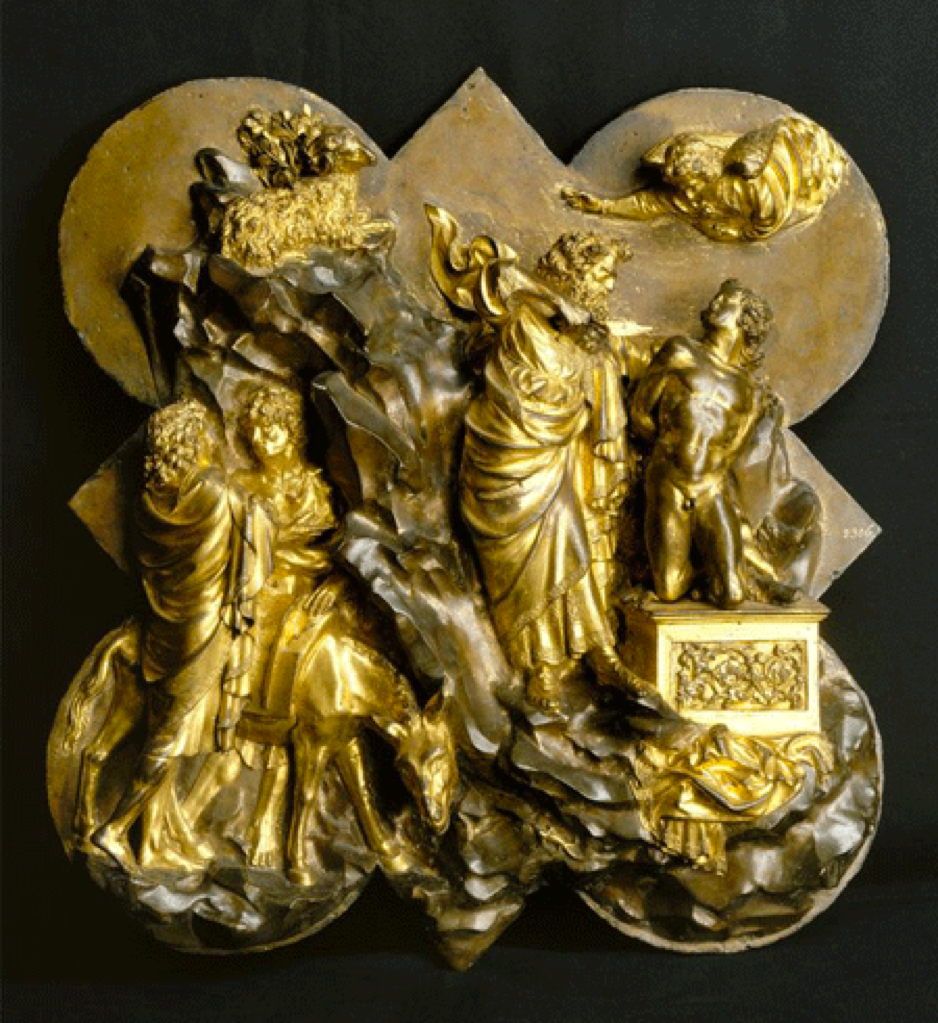
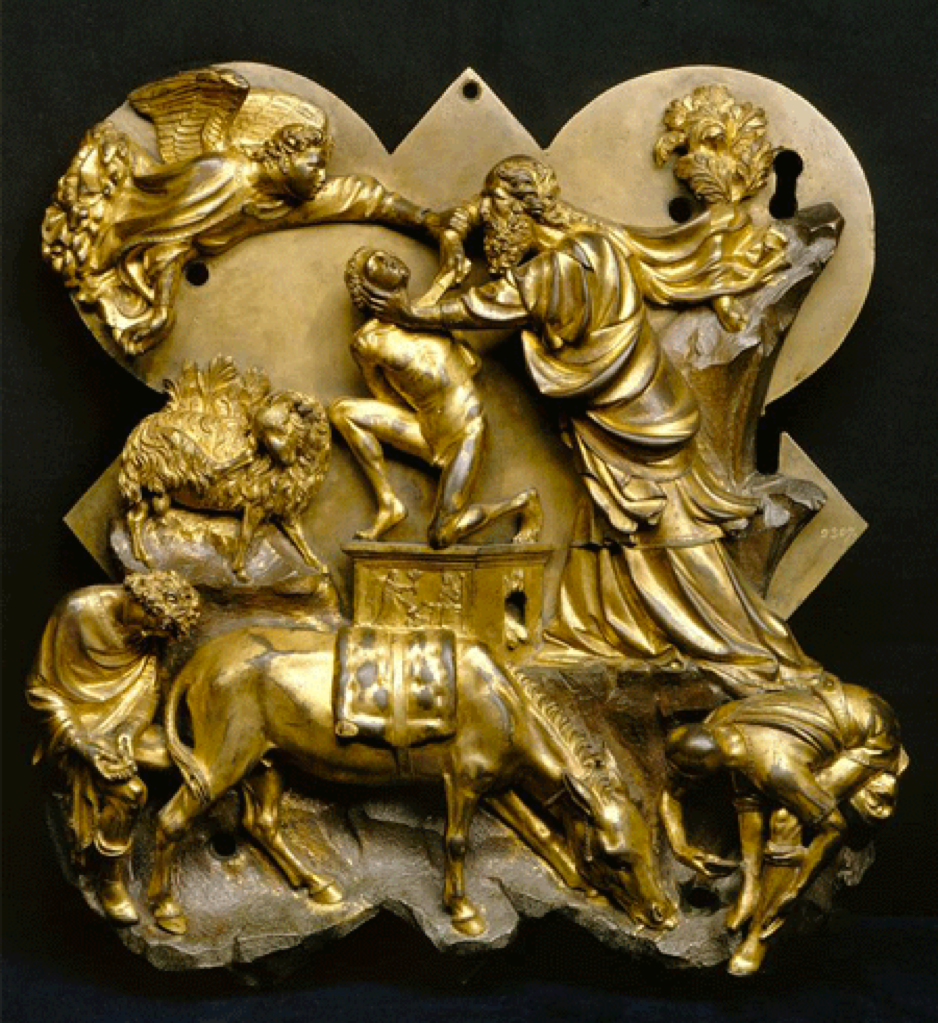
Left: Lorenzo Ghiberti, "Sacrifice of Isaac" (1401-1402). Right: Filippo Brunelleschi, "Sacrifice of Isaac" (1401-1402).
Thus, the Trecento is the infancy of the “work concept”, a concept central to all artistic endeavors today.
Evidence for societal awareness of an artistic milieu is quite available. During this century, we see the proliferation of scribal work, particularly in music, with composer attributions, even going as far as the luxurious depiction of composers in the Squarcialupi Codex. Numerous rhetoricians, orators, and poets, such as Francesco Petrarch and Dante Alighieri, received great acclaim in secular, academic, and sacred circles. The cities, aristocratic courts, and papacies across Western Europe were commissioning artists of renown, not merely from their local stock, but importing them, seeking only the best to compete with their political or spiritual rivals.
One example of this trade is artists come to us from the financial records of the lavish reign of Pope Clement VI (1291 – 1352; Pope from 1342 – 1352), the fourth Avignon Pope. Under his papacy vast sums were spent on cultural acquisition. Along with the commission of the Ivrea Codex, Clement VI hired artists like Matteo Giovannetti (c. 1322 – 1368) and purchased many lavish tapestries, requesting many depicted scenes of worldly hunting and fishing (rather than the expected Biblical or divine representations). We also know that for the many parties he hosted, Clement VI hired musicians from northern France, many of whom wrote music in the Ars Nova style. Philippe de Vitry, one of the most famous music theorists and composers of the day, was even on the payroll of the Pope. (Tomasello)
Clement know that art was not merely an enjoyable indulgence. It also was a weapon of political propaganda and cultural might, demonstrating one's ability and right to rule. The decor desired by Clement VI was designed to demonstrate the importance and legitimacy of the new (and controversial) pontifical residence at Avignon, France. To Matteo Giovannetti, Clement VI entrusted the decoration of Saint-Michel's, Saint-Martial's and Saint-Jean's chapels at Avignon. The mighty and grand architecture of the Palais des Papes (depicted below), the luxurious decorations by Giocanetti, and the sonic embellishments provided by composers and performers imported from across Europe, made the life, court, and worship of Clement the most impressive on the continent, helping to solidly his right to the contested papacy.


Matteo Giovannetti (c. 1322 – 1368), "The chapel of Saint-Martial" (1344-1345),
Palais des Papes, Avignon, France. Containing paintings of the life of Saint Martial.
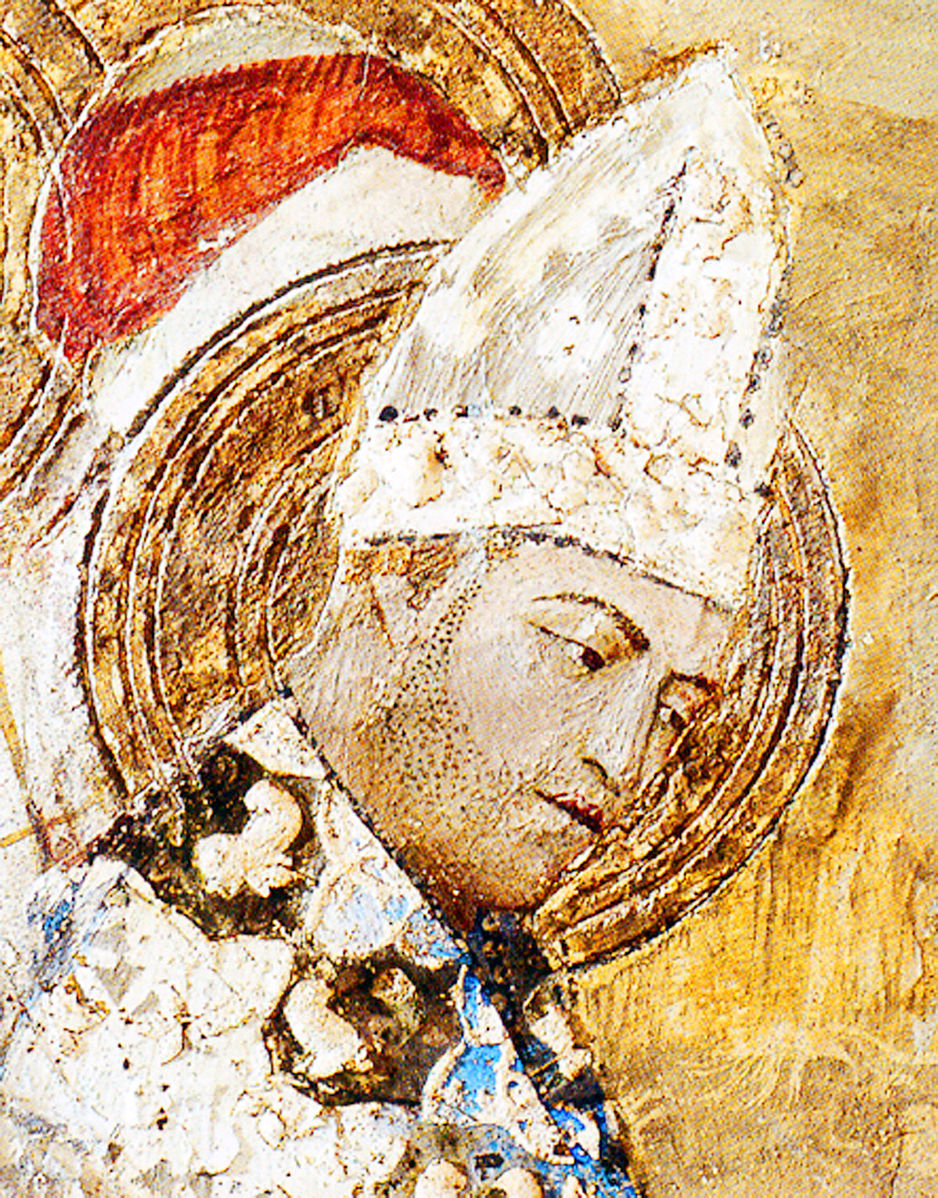
Detail of Clement VI as Saint Martial
(Fresque de la chapelle Saint-Martial du palais des papes),
painted by Matteo Giovannetti.
While men of high stature clearly saw the value and aesthetic merits of the art they commissioned, evidence for this same artistic self-awareness and critical critique among artisans themselves is far more scant. As is typical for most of artistic history, we rarely hear from the artists themselves about their own or other’s work. Our view is mostly confined to the writings of outside observers, critics, or theorists (if these even exist) or to the work itself and whatever hypotheses we can glean from it.
One of the most voluminous and comprehensive collections of musical art from the Trecento, the Squarcialupi Codex, provides us with at least one unique example of artistic self-awareness and open critique during the Trecento in Francesco Landini’s (c. 1325/35 – 1397) motet “Musica Son - Già Furon - Ciascun Vuol”, the text and translation of which are below. (For a performance score edition of the piece, as seen in the score-video, click HERE)
Francesco Landini: Motet, “Musica son – Gia’ furon – Ciascun vouli” (text)
CANTUS:
Musica son che me dolgo piangendo
Veder gli effecti mie dolcie profecti
Lasciar per frottol' i vagh' intellecti.
Perche 'ngnorantia 'n vici ongnun' chostuma
Lasciasi 'l buon' e pigliasi la schiuma.
I am Music, who weeping regret to see
intelligent people desert my sweet
and perfect effects for popular songs;
because ignorance and vice abound
good is deserted and the worst is seized.
CONTRATENOR
Gia' furon le dolcecce mie pregiate
Da chavalier', baroni e gran singnori,
Or sono 'n bastardita 'n gienti chori.
Ma i' musicha sol non mi lamento
Ch'ancor l' altre virtu lascia te sento.
Formerly my sweetnesses were prized
by knights, barons, and great lords.
Now gentle hearts are corrupted.
But I, Music, do not lament alone,
for I see even the other virtues deserted.
TENOR
Ciascun vouli narrar musical note
Et compor madria, chaccie, ballate,
Tenend' ongnun' in la su autenti charte.
Chi vuol d'una virtù venire in loda
Conviengli prima giugner' alla proda.
Everyone wants to arrange musical notes,
compose madrigals, caccias, and ballates,
each holding his own to be perfect.e
He who would be praised for a virtue
must first come down to earth.
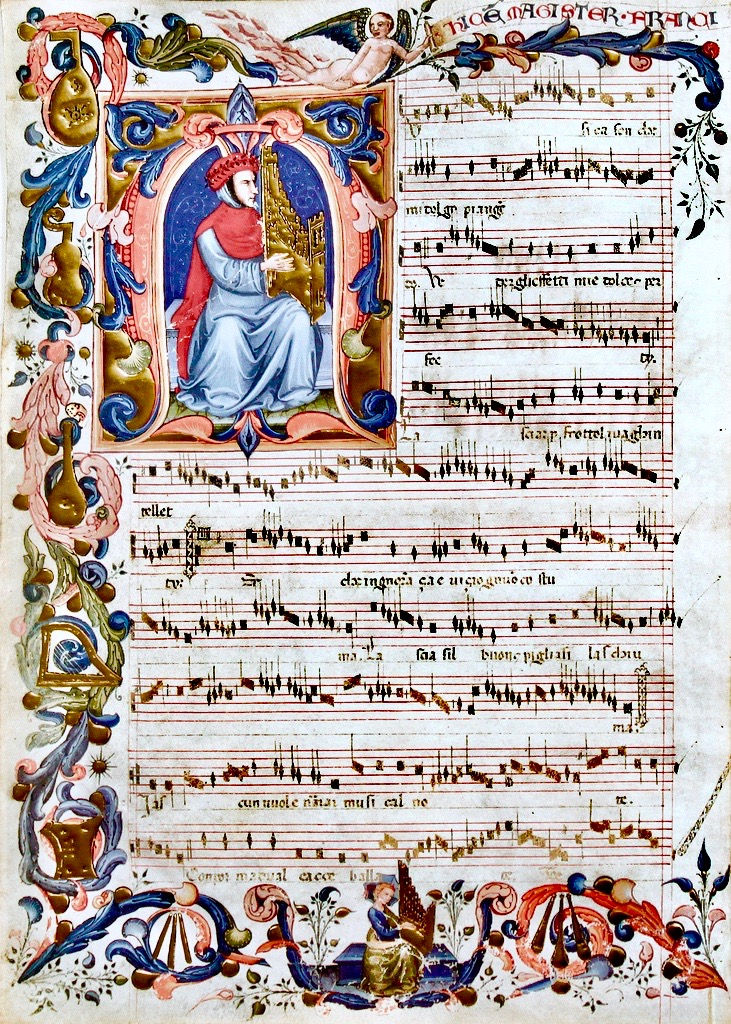
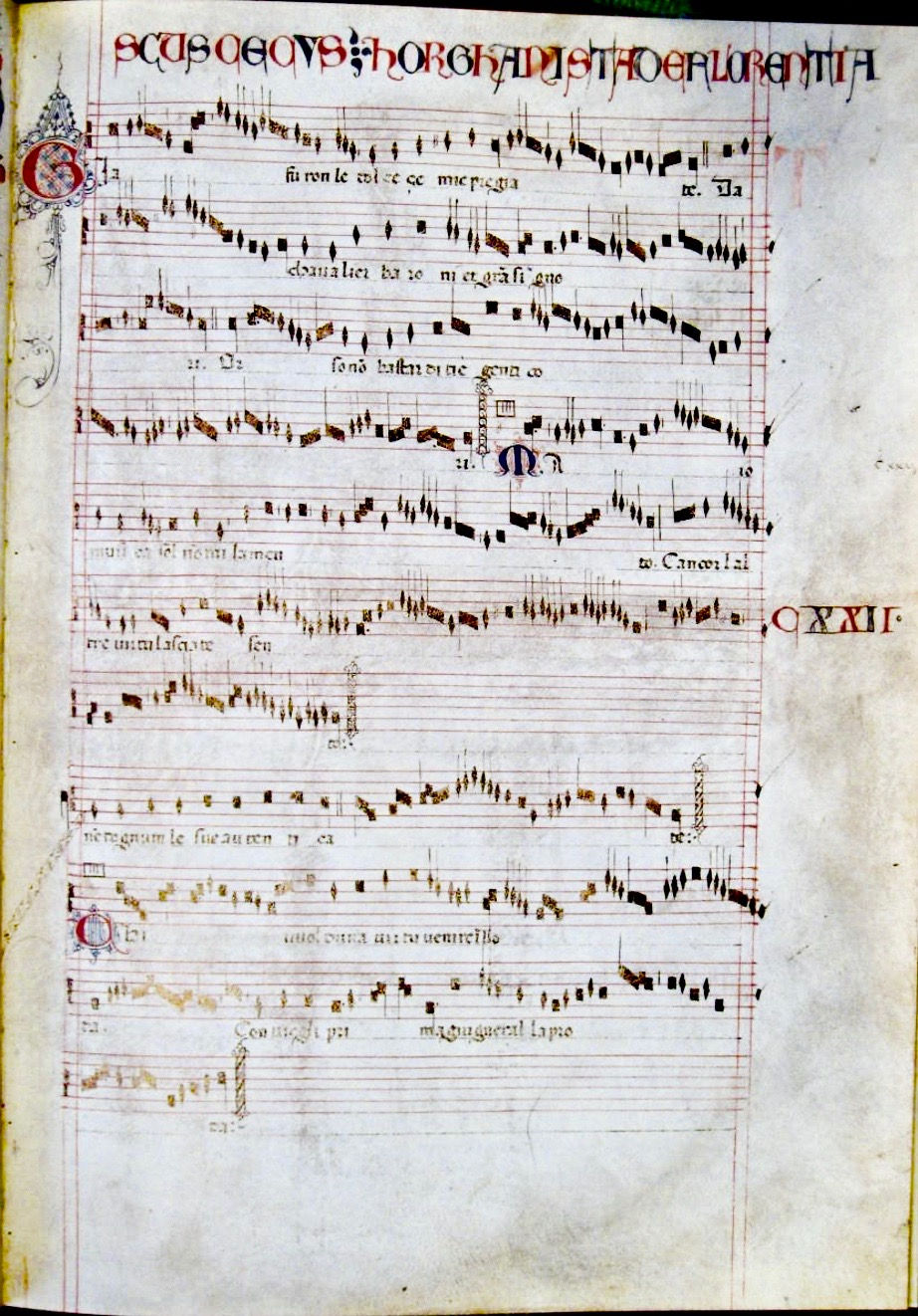
The codex itself is a product of humanistic sentiment, featuring many of the only known images of its featured composers juxtaposed with their names and pieces, giving strong attribution to almost every work. The exceptionally luxurious design of the attributions is typical for the entire codex: at the top, a cherub points to the composer while holding a scroll on which is written the composer’s name. The names are written in Latin across the top of adjoined leaves with the honorific “Magister”. The term magister, while fine translated as “teacher,” expresses a particularly high proficiency in an area of study, and so “specialist” or “professor” is a more accurate modern translation. Serpentine floral, pastoral, and various whimsical designs supply further decoration of the appellation pages and frequently illustrate aspects of the music shown with the portraiture. Such detail and expense to the end of attribution, particularly for men of less than noble status, is nearly unheard of before the Trecento.
Below: Squarcialupi Codex 121v-122r. [1] fol. 121v (excerpt) depicts Francesco Landini holding a portative organ. To the right is his piece “Musica son – Gia’ furon – Ciascun vouli”. Above him is an angel holding his appellation. [2] A detail of the angel with appellation "hice Magister Franci...". [3] detail of top of folio 122r with continued appellation "...scus Cecus Horghanista de Florentia". [4] detail of Landini from folio 121r. Put together, the appellation reads "this is Professor Francesco, blind organist of Florence"




The status of “Musica son” within Landini’s oeuvre as represented by the Squarcialupi Codex (or at least it’s status in the eyes of the codex’s compilers or commissioner) is perhaps implied by the piece’s placement as Landini’s first work displayed with his luxurious portraiture. Without question, this text, and consequently the music to which it is set, is a critique by Landini of some of his contemporaries. We are not told which specific group is the target of his derision, but we can deduce that this group must in some way share the same function as Landini within the production of music, since they are producing the same genres of music as Landini (i.e. madrigals, caccias, and ballates). What then must be different is not the type of music being produced but some difference in “virtue” or quality within a style or practice, setting a clear hierarchy between good or “virtuous” and bad or “corrupted” music making.
Ultimately, Landini implicates not all madrigals, caccias, and ballates are equal, and we must assume, as probably did his contemporaries and following generations, that Landini, one of the most acclaimed composer’s of his day, was an authority on this matter. His authority as a master musician and composer is given by the panoply of musical instruments surrounding the composer on his appellation page, a rather unique and suggestive use of these images in the codex (see below). Unfortunately, Landini has left us with few qualifications with which to judge music, and as far as contemporary theoretical treatises teach us, if the counterpoint is correct the music is legitimate. However, it seems likely that Landini is judging music not only on contrapuntal merits or one’s ability to “arrange musical notes”. Rather, to “be perfect” or “praised for a virtue” it seems that merely “arranging musical notes” is not enough. On what then could Landini be judging the merits of his contemporaries’ music?









Given the growing popularity of humanism and its study through the Trivium among the educated middle and upper European classes, we might consider an answer to this question beyond the scope of the musically quantitative (i.e. counterpoint), and ask this question to the qualitative aesthetics of humanism and rhetoric in general.
We know with certainty Franco-Flemish composers as early as Philippe de Vitry (1291-1361) affiliated with rhetoricians and intellects of note. Vitry had numerous correspondences with Petrarch (1304-1374), who called Vitry "...the keenest and most ardent seeker of truth, so great a philosopher of our age."[5] He also befriended mathematician, philosopher and music theorist Nicole Oresme (c. 1320/25-1382)[6], one of the most innovative thinkers of his day. Holding several canonries, operating as Bishop of Meaux, serving as composer for the Avignon papacy under Clement VI and the courts of Charles IV, Philippe VI, and Jean II, Vitry moved in the most important Franco-Flemish cultural circles, both sacred and secular, of his time. Furthermore, frequently referred to as “Magister,” Vitry was probably well educated, likely at the University of Paris, in the Trivium and Quadrivium. (see Sanders) Being a prominent 14th century Burgundian composer, Vitry’s scholasticism would likely influence later generations of composers, like Landini.
Rhetoric has taken many methodological and aesthetic guises in European culture since its origins in Classical Greece, but the characteristic that unites these disparate interpretations is rhetoric’s art of persuasion through argument and/or critique, both frequently reinforced by some system of logic. During the Middle Ages, the art of rhetoric was largely lost and only kept alive in a modicum of sources. However, the dawn of the Renaissance in the late 14th and early 15th century witnessed the rediscovery and widespread popularity of Greek literature and rhetorical theory. Renaissance rhetoric was not confined merely to cultural elite, but became a substantial part of all movements through its impact on educational reforms under the Humanists. Through proliferation of scribed and newly printed sources and its implementation in all levels of education, rhetoric comprehensively impacted society (Plett, Renaissance Rhetoric, 673).
According to Thomas Conley, rhetoric became “an alternative to the use of force” as an “art par excellence of persuasion”. It became a method of “deliberation by examination of alternatives in place of autocracy,” providing “a mode of analysis and judgment suited to the resolution of problems of fact and of action.” (Conley 110) The art of rhetoric as a mode of critical thought and and its service to oration became the crux of Humanism's rational bent.
It was through introductory education in the Trivium one would become familiar and fluent with rhetoric’s art. During the Middle Ages and Renaissance, and even today, the Trivium was the threefold method of critical thought. It consisted of grammar, logic, and rhetoric and formed the foundation of the seven liberal arts, of which the Quadrivium of arithmetic, geometry, music, and astronomy formed the upper part. Grammar was the most fundamental skill for the young student learning the basic mechanics of language and the concepts it defines. Logic was the next level, instructing one in the proper use of grammar as a tool of analysis. Through grammar and logic, one was able to generate factual, verifiable knowledge, which by rhetoric, the last level of the Trivium, one could then persuasively convey or justify. Ultimately, the student of the Trivium learned how to compose prose using the precepts of rhetoric - inventio, dispositio, elocutio, pronunciatio, and memoria - and arrange prose into the archetypical structure of the argument - exordium, narratio, confirmatio, refutatio, and conclusio. (Vickers 3)
Beyond simple practical matters of politics and law, rhetoric found its first bastion during the late Middle Ages and early Renaissance in poetics through the theory of style. (Plett, The Place and Function, 356) Before style, however, rhetoric consisted of two phases in the production of oratory: the inventio and the dispositio, or the search of an argument and the structuring of that argument respectively.
Dispositio has its own taxonomy for properly structuring an argument. This taxonomy includes exordium (introduction), narratio (narration or statements of fact), partitio or propositio (division or outline of the argument), confirmatio (proof of the argument’s thesis), to refutatio (address of refutations to the thesis), and peroratio or conclusio (peroration or conclusion, summarizing the argument). This taxonomy is commonly called the “classical argument.”
Within this rhetorical model, the theory of style (elocutio) constitutes prose’s third phase of production after inventio and disposition. It possesses three parts of its own: the stylistic principles (virtutes elocutionis), manners (genera dicendi), and figures (figuras). (Ibid.) Plett describes these three components as follows:
Stylistic principles: “Some kind of systematic representation, generally based on… various forms of deviation from the linguistic norm.”
Manners: “A functional explanation of the stylistic devices….”
Figures: “An evaluation of the stylistic devices… as either acceptable or unacceptable” in one’s specific situation. (Plett, The Place and Function, 358)
These three elements – systematic, functional, and evaluative – form what Plett calls one’s “stylistic norm.” (Ibid.) Elocutio is the orator’s source of expressiveness and eloquence (perhaps even grandiloquence), traditionally associated with rhetoric. During the height of Renaissance rhetorical studies, Italian scholar Julius Caesar Scaliger composed his Poetics Libri Septem, in which he outlined what he considered the four “virtues” (note the parallel with Landini’s use of the word) of well constructed prose (“quatour virtute poetae”), elaborating on the theory of style. These virtues were prudentia, efficacia, varietas, suavitas. He describes the virtues in the 25th chapter of the third book of Poetics Libri Septem. He writes:
Quorum vtrunque consecuturi sunt ii, qui & res vero propiotes, ac sibiipsis semper conuenientes exequuti fuerint, A operam dederint vt omnia varietate condiantue. Nihil enim infelicium, quàm saturare auditorem antè, quàm explaetur. Quae enim epulae quibus fastidium pro voluptate pariatur? Tertia res ea est, quam ego Efficaciam, Graeci quo designent nomine suo loco dictum est. Eam paucis in Poetis reperies. Est autem vis quaedam tum rerum, tum verboruum, quae etiam nollentum propellit ad audiendum. Quarta est suauitas, quae efficaciae illius vim vegetam deducit ex asperitate, cui saepenumero est affinis, ad certam temperationem. Haec igitue esto summa sic: Poetae pridentia, varietas, efficacia, suauitas. (Scaliger, "Book 3", 113.)
Frederick Morgan Padelform provides a translation for this passage:
“Now to realize these ends, one’s work must conform to certain principles. In the first place his poem must be deeply conceived, and be unvaryingly self-consistent. Then he must take pains to temper all with variety (varietas), for there is no worse mistake than to glut your hearer before you are done with him. What then are the dishes which would create distaste rather than pleasure? The third poetic quality is found in but few writers, and is what I would term vividness (efficacia); there is also a Greek name for it which will be given in the proper place. By vividness I mean a certain potency and force in thought and language which compels one to be a willing listener. The fourth is winsomeness (suauitas), which tempers the ardency of this last quality, of itself inclined to be harsh. Insight and foresight (predentia), variety, vividness, and winsomeness, these, then, are the supreme poetic qualities.” (Scaliger, Select Translations, 53)
To summarize, prudentia demands a rich and well-constructed argument (inventio); efficacia, a vivid and compelling depiction; varietas, a varied and efficacious arrangement of ideas; and suavitas, a generally pleasant tone. Inventio, dispositio, and elocutio constitute rhetoric’s core. (For a more information on the parts of rhetoric see Vickers, Brian. In Defence of Rhetoric. Oxford: Clarendon Press, 1988. 62-67)
Given rhetoric’s and music’s paralleled configurations, such as their temporal linear unfolding, performative delivery, and rudimentary concept of the “work,” analogies were inevitably drawn between the two. Through introduction of rhetorical terms throughout the Renaissance as a standard for poetic composition, music (and the other arts) consequently migrated into greater proximity with rhetoric through poetry, elevating it above its medieval anagogics and demanding it make a logical, comprehensible impression on human intellect.
Given one masters the fundamental art of the musically quantitative, it is ultimately the “logical, comprehensible impression on human intellect” that Landini seeks in his and his contemporaries work. If proper counterpoint fulfills the virtue of suavitas, then the level to which one can invoke prudentia (a well-constructed argument), efficacia (a compelling depiction), and varietas (an efficacious arrangement of ideas) ultimately determines the success of musical art.
It is impossible for us to know with certainty which pieces Landini considered “virtuous,” even within his own oeuvre. All we can know with certainly is that there exist some pieces that might be considered of lesser quality and some of greater quality as judged by one imminent artesian-artist of the day. Of course, the degree to which a piece of music may fulfill aspects wholly quantitative (prudential, efficacia, and varietas) is highly subjective, even taking the most paradigmatic examples from the day. However, while there are many contemporary manuals for “musical grammar and syntax” (harmonics, mode, and counterpoint) there is no manual of “musical rhetoric” from this period (i.e. what specifically makes music compelling). Simply put, one can learn the proper way to construct a canon from a counterpoint treatise, but one cannot learn how to make an interesting, engaging, dramatic, or perhaps “artistic” (“virtuous”) canon.
What then would be an example that Landini could have possibly pointed to that would be a model for “virtuous” music. If one “arranged musical notes” into a canon (or caccia) for example, how could they accomplish something more distinguished than a correct execution of the rules of counterpoint familiar to a 14th century Italian musician? Is there a distinguished example that we can look to that demonstrates the qualities of prudential, efficacia, and varietas?
One poignant example which also comes from the Squarcialupi Codex is Gherardello da Firenze’s caccia “Tosto che l’alba”. In this canonic piece, Gherardello is not only successful in composing a text to a contrapuntally correct canon, but also attempts to parallel the sounds and excitement of a hunt inherent in the text in a dynamic musical narrative.
First, the rapid compound meter give the piece an upbeat, running, ebullient feel that one might have as they leave home the morning of the first hunt of the season. The off-beat hocketting we first hear in measure 9 of the appended performance score heightens the sense of excitement and ebullience at the anticipation of the hunt. The hunters. are waking up, getting ready, and heading out, and one might imagine that they are talking over each other and tripping over themselves in the excited preparation of their day in the mountains. By measure 11, the music has broken out into full development, with all voices “awakened” and a rhythmically excited cadence at the first melodic apex on F5 (sounding an octave lower). The excitement of the music is paralleled by the mood of the text at this moment.
From measure 11, the piece skips along as the hunters prepare themselves for their day of adventure. They arouse each other, the dogs, and then wake “Viola” and “Primera”.[20] Up until about measure 18, we are firmly oriented about F-Ionian, which perhaps ornaments the excited rhythm of the music with a sense of gaiety – at least to our modern ears. However, by measure 18 we begin to move out of an F-Ionain center, and by measure 23, we are firmly in a new center on A-Aeolian once everyone is “in place… on the mountain’s side”, as the text of the measure translates. The A-Aeolian mood persists until the Ritornello beginning in measure 47. The transition to the new minor-inflected mode further heightens drama of the music. With a move from what we hear as “major” to “minor”, we add a sense of anxiety – a move from simple excitement upon waking for the hunt to the excitement of the hunt itself, a mood tinged with the adrenalin as everyone waits on the mountain with the anticipation of the approaching kill.
The music from measure 23 to 30 stays within a confined range and does not escape into the melodic extremes until the “Sta' avvisato!” (“Watch out!”) of measure 30. At this point, the melody does a literal “call”, all re-percussed on the high F5. As used before to call everyone awake in measure 11, the high F5 is used here again to call everyone to attention, drawing narrative parallels across the musical dialogue.
After this call to attention, the melody drops again, telling everyone to “Beat the bushes on every side” in search of the prey. Once “the horn is sounding” again in measure 34, both voices break into the high extreme of their range. The comes (or following voice of the canon) calls out again with “Sta' avvisato!” (“Watch out!”) and the dux (or leading voice of the canon) hits the highest point in the entire piece on a high-A5, calling out “Ayò, ayò! A te la cerbia vene!” (“Hey, hey! The deer is coming your way!”), either imitating the excited call of the hunter to his companions or the sound of the horn. Cleverly, this musical portrayal blurs the lines between the sound of the horn and the call of the man. Furthermore, both canonic voices cleverly arrive at the same time to this climatic point, each reinforcing the other’s excitement.
The high range and excitement this moment brings are maintained until the second voice (comes) does its call on high-A. After this call in measure 40 through 42, the music winds down as the dog, “Carbon”, has caught the prey. The piece moves quickly from a strong center in A-Aeolian back into the original center of F-Ionian, guiding the emotional transition away from the anticipation of the kill and back to the jubilation of the beginning.
The hunt is not over however! The mood of the music suddenly changes with the arrival of the Ritornello (“refrain”) section, accompanied by a dramatic shift in modality to G-Dorian. One of the hunters “who was up on the mountain” calls out to remind us that there is more hunting to be had. While we might be satisfied with our first success, the day is long from over. He calls out, “Now to the other deer!” and then he blows his horn. The singing voices cleverly imitate the sound of alpine horn calls in measures 52 through 56 with the perfect-fourth leaps between high D5’s and G5’s. The piece then comes to a quick close with a cadence from G to the original tonal center of F.
A video-score with recording of "Tosto che l'alba" or click here to view on YouTube.
While the piece is simple in is contents and generative form, Gherardello has done a subtly masterful job in making a process oriented piece, like a caccia or canon, into a convincing and dramatically compelling vignette. First, he has accomplished this by timing critically dramatic arrival points of the voices so that they coincide. Second, he has used the tenor voice to cleverly reorient the harmony of the upper voices so that we have emotional shifts throughout the piece, which parallel the emotions implied by the text. Last, he has used to singing voice in such a way as to imitate the sounds of the natural voice and the hunting horn, all to serve the context of the text’s dramatic arch. It is clear on many levels why this was and is considered the greatest recorded work of Gherardello.
Thus, this canon is not only a cleverly and carefully constructed piece, but, as it clearly fuses music and narrative into a relatively complex drama, it becomes a piece of musical oration composed with an eloquent and compelling rhetoric through prudentia, efficacia, and varietas.
Gherardello da Firenze’s caccia “Tosto che l’alba” is but one piece by a contemporary that Landini clearly might have praised as “virtuous”. However, the question remains as to whether these same rhetorical standards can be used to qualitatively judge the merits of other contemporary pieces and perhaps find them wanting based on the humanistic standards of the day. Such a method could suggest a more accurate and limited repertoire of veneration. Rather than taking the vast array of pieces available to us from the 14th century and measuring them all as equal due to their correct contrapuntal execution or the composer to which they are attributed, perhaps we can deduce those pieces of higher merit within a composer’s repertoire or a generation. Under the lens of humanistic rhetoric, we can begin analyzing music from the 14th and 15th century with a more qualitative approach, relying less on a composer’s ability to write correct counterpoint, imitation, cadence, etc., and more on their ability to understand and employ a common system of syntax and grammar in service to a unique, compelling, and artistic musical oration.
Bibliography
Primary Sources:
Biblioteca Medicea-Laurenziana [I-Fl], MS Mediceo Palatino 87 “Codex Squarcialupi”,
no. 40 fol’s 25v-26r & 121v-122r.
Bibliothèque Nationale [F-PN], MS fonds italien 568 “Pit”,
no. 40 fol. 25v-26r.
British Library [GB-Lbl], Add. MS 29987, no’s 11 & 31.
Secondary Sources:
Conley, Thomas M. "Rhetoric and Renaissance Humanism." In Rhetoric in the European Tradition,
109-50. London; New York: Longman, 1990.
Plett, Heinrich F. "Renaissance Rhetoric: An Overview." Encyclopedia of Rhetoric. Ed. Thomas O. Sloane.
Oxford: Oxford UP, 2001
______. "The Place and Function of Style in Renaissance Poetics." Edited by James Jerome Murphy. In
Renaissance Eloquence: Studies in the Theory and Practice of Renaissance Rhetoric, 356-75. Berkeley: University of California Press, 1983.
Sanders, Ernest H. "Philippe de Vitry". The New Grove Dictionary of Music and Musicians, ed. Stanley
Sadie. 20 vol. London, Macmillan Publishers Ltd., 1980.
Scaliger, Julius Caesar. "Book 3: ‘Tertii Libri Qui Et Idea Inscribitur’ Chapter 25: ‘De Quatuor Virtutibus
______. Select Translations from Scaliger's Poetics. Translated by Frederick Morgan Padelford. New York: H. Holt, 1905. 53
Tomasello, Music and Ritual at the Papal Court of Avignon 1309–1403, 12–20
Vickers, Brian. "Figures of Rhetoric/Figures of Music?" Rhetorica: A Journal of the History of Rhetoric 2, no. 1 (1984).
______. In Defence of Rhetoric. Oxford: Clarendon Press, 1988. 62-67
Tertiary Sources:
Ernest H. Sanders and Peter M. Lefferts. "Voice-exchange." Grove Music Online. Oxford Music
Online. Oxford University Press, accessed December 18, 2016,
http://www.oxfordmusiconline.com/subscriber/article/grove/music/29617.
Kurt von Fischer and Gianluca D’Agostino. "Caccia." Grove Music Online. Oxford Music
Online. Oxford University Press, accessed December 18, 2016,
http://www.oxfordmusiconline.com/subscriber/article/grove/music/04517.
______"Gherardello da Firenze." Grove Music Online. Oxford Music Online. Oxford University
Press, accessed December 18, 2016,
http://www.oxfordmusiconline.com/subscriber/article/grove/music/11019.





































Comments